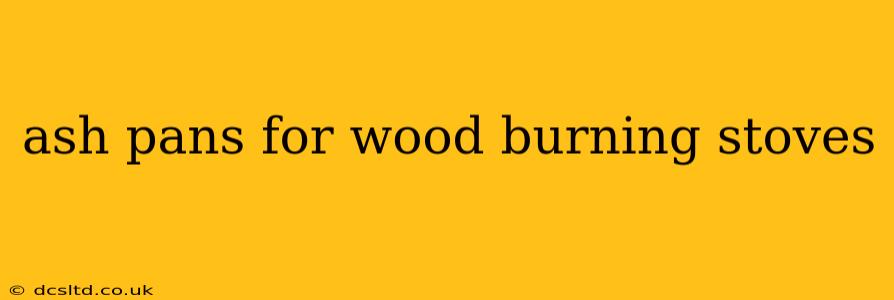Wood burning stoves offer a cozy and efficient way to heat your home, but maintaining them requires regular ash removal. This is where the humble ash pan comes in. This guide delves into everything you need to know about ash pans for wood burning stoves, addressing common questions and helping you choose the right one for your needs.
What is an Ash Pan and Why Do I Need One?
An ash pan is a crucial component of most wood burning stoves. It's a metal container located at the bottom of the stove, designed to collect ash and embers produced during the burning process. Its primary function is to keep the ash contained, preventing it from scattering around your home and making cleanup much easier. Beyond convenience, a well-functioning ash pan contributes to the overall safety and efficiency of your stove.
Different Types of Ash Pans: Finding the Right Fit
Ash pans vary in design and functionality depending on the stove model. Some are simple, removable trays, while others are integrated into the stove's base. Consider these key factors when choosing an ash pan:
- Material: Most ash pans are made of durable steel, capable of withstanding high temperatures. Some higher-end models might utilize cast iron for added robustness.
- Size and Capacity: The size of the ash pan should be appropriate for the size of your stove. A larger capacity means less frequent emptying.
- Removable or Integrated: Removable pans offer easier cleaning, while integrated pans might be more aesthetically pleasing, but can be more challenging to clean thoroughly.
- Features: Some ash pans include features like handles for easy removal, or even built-in wheels for easier maneuvering.
How Often Should I Empty My Ash Pan?
This depends on how frequently you use your wood stove and the type of wood you burn. As a general rule, you should aim to empty the ash pan when it's about one-third to one-half full. Leaving it overly full can restrict airflow, impacting the stove's efficiency and potentially leading to dangerous situations like smoldering embers escaping.
What Should I Do with the Ashes?
Once you've removed the ashes, allow them to cool completely before disposing of them. Never dispose of hot ashes in plastic bags or other flammable materials. The safest method is to store them in a metal container outdoors, away from combustible materials, until they are completely cold. Afterward, you can usually dispose of them in your regular household trash, but it's advisable to check with your local waste management guidelines.
Can I Use My Wood Stove Without an Ash Pan?
While some older stoves might not have ash pans, it's generally not recommended to operate a wood stove without a proper ash-collection system. Doing so poses a significant fire risk and makes cleaning considerably more difficult and messy. The risk of embers escaping and causing a fire is significantly higher.
How Do I Clean My Ash Pan?
Regular cleaning is crucial for maintaining your ash pan's efficiency and longevity. After emptying the ashes, you can usually brush or wipe down the pan to remove any residual ash. For stubborn buildup, a mild detergent and water can help, followed by thorough rinsing and drying.
My Ash Pan is Leaking – What Should I Do?
A leaking ash pan is a problem that requires immediate attention. If you have a removable pan, check for any cracks or damage. If the leak persists, you may need to replace the ash pan. Contacting your stove's manufacturer or a qualified professional is recommended.
Where Can I Buy a Replacement Ash Pan?
Replacement ash pans can often be purchased from the manufacturer of your stove, online retailers specializing in wood-burning stove parts, or from local fireplace and hearth supply stores. When ordering a replacement, ensure that you specify the exact make and model of your stove to ensure a perfect fit.
This comprehensive guide should provide you with all the necessary information about ash pans for wood burning stoves. Remember, proper ash pan maintenance is key to ensuring the safe and efficient operation of your stove.
